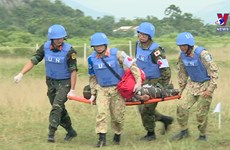Vaccination shipment to ease local shortages
About 30,000 doses of "five-in-one" vaccine and 200,000 doses of
"six-in-one" vaccine will be imported next month to use in the nation's
immunisation programme, said Nguyen Tran Hien, director of the programme.
About 30,000 doses of "five-in-one" vaccine and 200,000 doses of
"six-in-one" vaccine will be imported next month to use in the nation's
immunisation programme, said Nguyen Tran Hien, director of the programme.
The "five-in-one" vaccine protects against diphtheria, tetanus, whooping cough, polio and haemophilus influenza type B. The "six-in-one" vaccine also protects against hepatitis B.
The importation would ease a shortage of vaccines since the beginning of this year, said Hien.
Vietnam has two immunisation programmes - the national immunisation programme and immunisation services.
The Ministry of Health supplies 11 free vaccines, including those against tuberculosis, diphtheria, polio and whooping cough to the national immunisation programme.
Funds for the programme come from the State and the ministry's budget.
Immunisation services also provides vaccines for chicken-pox, flu and meningo-encephalitis.
Every year, the country needs about 35-40 million doses of vaccine for the national immunisation programme and more than three million doses for the immunisation services programme.
Hien said that low awareness in some parts of the country and a few reports about negative reactions had led to a big fall in demand for vaccines.
Many enterprises imported vaccines last year, but could not sell them all. So they reduced the amount imported this year.
To ensure a stable supply for the immunisation services programme, Hien suggested close cooperation between the immunisation stations and domestic vaccine enterprises.
Hien said Vietnam also needed a project to forecast the demand for the vaccines. Projections would be based on forecasts and the capacity of manufacturers to supply the goods.
Dissemination for residents about the necessary of vaccine was also needed.
Social associations, for instance the Vietnam Preventive Medicine Association, should be encouraged to join the immunisation services programme.
"With experienced members who have work in the health sector for long time, the association can give exact annual forecast about disease and help increase the community's awareness on immunisation-related problems," said Hien.
Information technology application should also be improved to better manage the immunisation programme, he said.-VNA
The "five-in-one" vaccine protects against diphtheria, tetanus, whooping cough, polio and haemophilus influenza type B. The "six-in-one" vaccine also protects against hepatitis B.
The importation would ease a shortage of vaccines since the beginning of this year, said Hien.
Vietnam has two immunisation programmes - the national immunisation programme and immunisation services.
The Ministry of Health supplies 11 free vaccines, including those against tuberculosis, diphtheria, polio and whooping cough to the national immunisation programme.
Funds for the programme come from the State and the ministry's budget.
Immunisation services also provides vaccines for chicken-pox, flu and meningo-encephalitis.
Every year, the country needs about 35-40 million doses of vaccine for the national immunisation programme and more than three million doses for the immunisation services programme.
Hien said that low awareness in some parts of the country and a few reports about negative reactions had led to a big fall in demand for vaccines.
Many enterprises imported vaccines last year, but could not sell them all. So they reduced the amount imported this year.
To ensure a stable supply for the immunisation services programme, Hien suggested close cooperation between the immunisation stations and domestic vaccine enterprises.
Hien said Vietnam also needed a project to forecast the demand for the vaccines. Projections would be based on forecasts and the capacity of manufacturers to supply the goods.
Dissemination for residents about the necessary of vaccine was also needed.
Social associations, for instance the Vietnam Preventive Medicine Association, should be encouraged to join the immunisation services programme.
"With experienced members who have work in the health sector for long time, the association can give exact annual forecast about disease and help increase the community's awareness on immunisation-related problems," said Hien.
Information technology application should also be improved to better manage the immunisation programme, he said.-VNA













